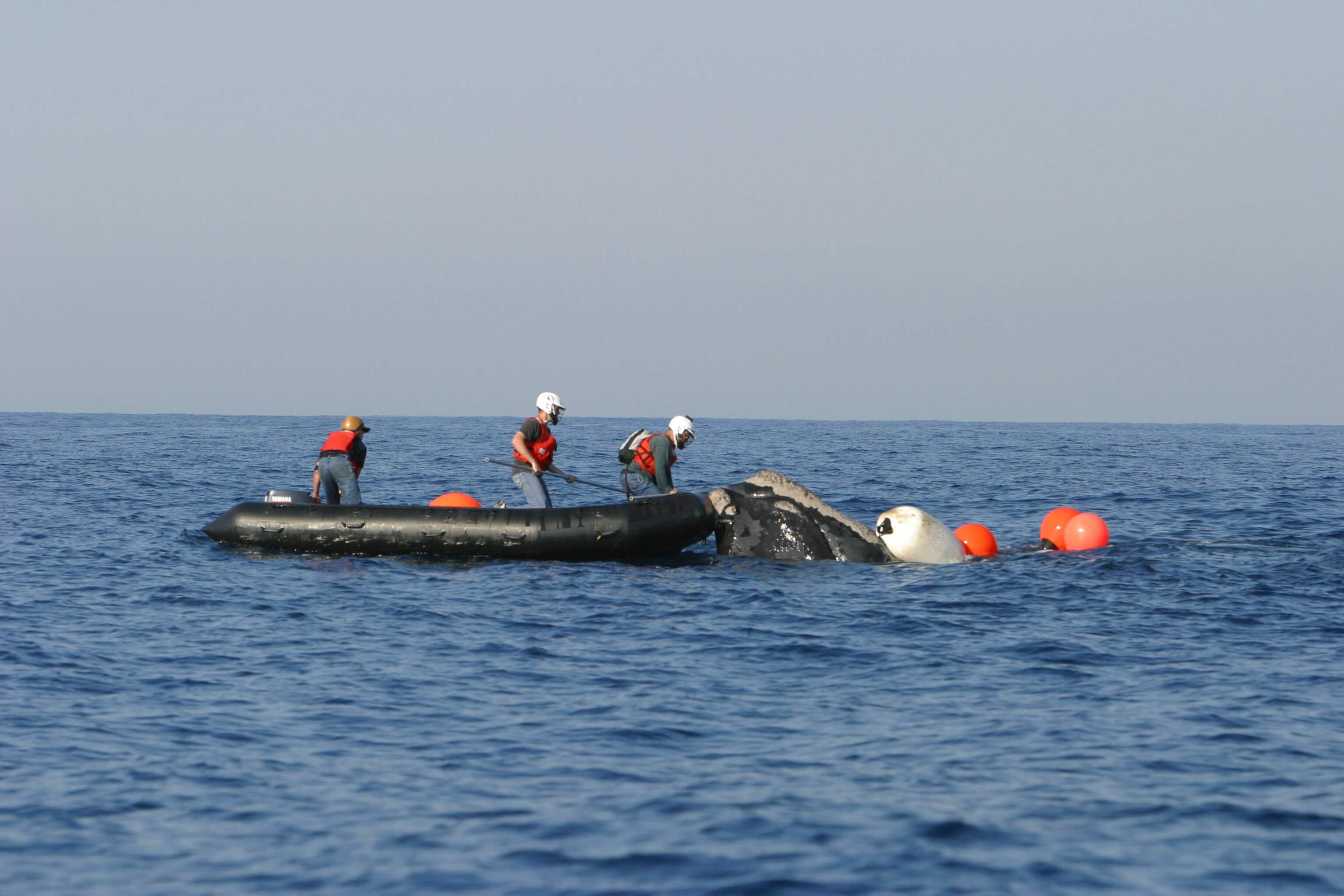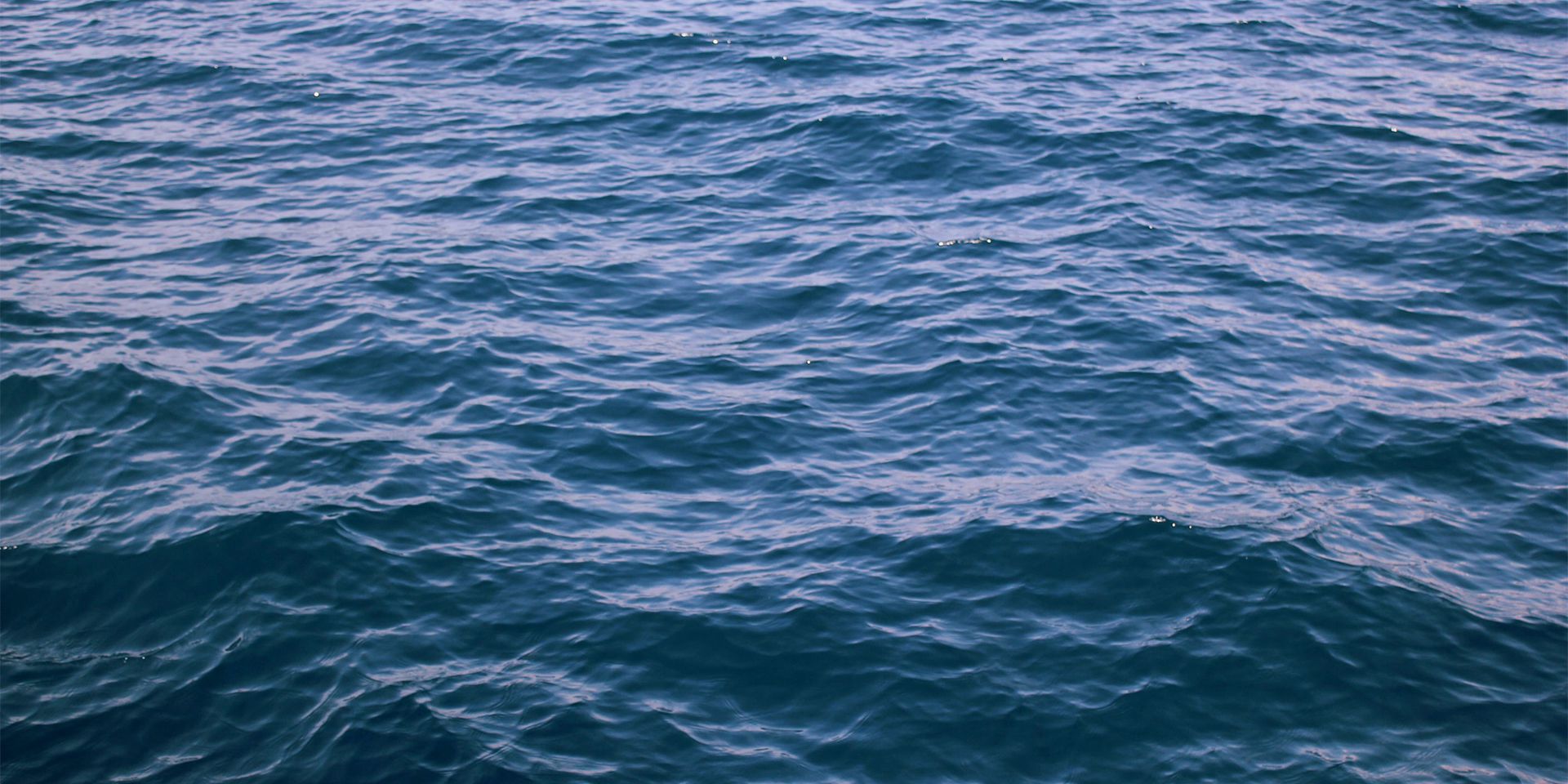Right Whales and Entanglement in Fishing Gear

NOAA scientists and partners attempt to disentangle endangered right whale.
The National Marine Fisheries Service (NMFS) has implemented many regulations since the late 1990s as part of an Atlantic Large Whale Take Reduction Plan to reduce entanglement-related deaths of right whales. Most of those deaths are caused by lines associated with lobster traps and gillnets. To date, there is no evidence demonstrating that those regulations have been effective. In fact, right whale deaths attributed to fishing gear have increased substantially since rulemaking efforts began in 1997. Whereas there were two confirmed deaths linked to entanglement from 1990 through 1999, there were eight from 2000 through 2009, and eleven from 2010 through 2016 (see chart on the right whale mortality and injury page). How many additional deaths go unrecorded is unknown, but it could be half to two-thirds of all deaths.
On July 16, 2013, NMFS proposed a third major revision to its Take Reduction Plan. This revision focused on reducing entanglement risks in buoy lines (also called endlines) that extend from bottom-set traps and gillnets up to surface marker buoys. To reduce such risks in New England waters, NMFS proposed limiting the number of endlines by bunching more traps on fewer endlines and establishing three new seasonal closures for right whale habitat in Massachusetts Bay, on Jeffries Ledge off southern Maine and New Hampshire, and in Jordan Basin in the central Gulf of Maine. South of New England, a different strategy was proposed whereby the number of traps on a trawl was reduced rather than lengthened and low-breaking-strength buoy lines was to be required prevent any entangled calves from having to tow long, heavy lines of traps. On August 5, 2013, we supported the proposed measures, but noted that they were still inadequate and recommended numerous supplemental provisions. We recommended that seasonal closures applying only to trap fisheries be expanded to include gillnets; that rules for gear marking should be expanded to allow identification of additional gear types and fishing areas from lines removed from whales; and that fishermen be required to record data on the number and location of deployed endlines. We also noted that the “co-occurrence” model used to assess entanglement risks (a spatial model used to compare monthly densities of whales and fishing gear across different geographic areas) was inadequate for management purposes. We noted that the model needed to be modified and applied before the rule was finalized to prevent underestimating entanglement risks and overestimating expected risk reduction.
On June 27, 2014, NMFS published a final rule to amend its take reduction plan that did not include our recommendations and eliminated key protection measures that had been initially proposed. Two proposed closures in the Gulf of Maine (one at Jeffreys Ledge and the other in the Jordan Basin) were removed; areas exempt from endline requirements were expanded, and most nearshore lobstermen in Maine (representing perhaps half of all endlines set along the U.S. East Coast) were exempted from gear marking requirements. The agency also deferred implementation of the rule in New England until June 2015. The final rule also included no measures requiring fishermen to record data on the number or location of deployed endlines although such data was needed to determine whether endline numbers were actually reduced.
After the final rule was adopted but before it became effective, several other changes were made. In August 2014, the Massachusetts Division of Marine Resources requested that it be amended to shorten the effective period of the one remaining time-area closure—a seasonal lobster fishing closure covering Cape Cod Bay and adjacent areas. The rules closed the area to lobster fishing from January 1 to April 30. The state requested that the seasonal starting date for the closure be changed from January 1 to February 1 to allow economically important fishing in the area to continue in early January and provide time to remove pots from the water in late January. To compensate for reduced whale protection in January, the State proposed expanding the management area’s boundaries to include fishing areas in important right whale habitat to the south of the management area along the edge of the Great South Channel. Analyses using the co-occurrence model suggested that a shortened closure period with the expanded area would produce the same net conservation benefit and, after consulting the Take Reduction Team by teleconference in October 2014, the team agreed to support the proposed change. NMFS therefore proposed a rule on November 6, 2014 to change the effective start date and boundaries of the Massachusetts Restricted Area. We commented in support of the proposed change on November 21, 2014 and on December 12, 2014 a final rule was adopted making the State’s requested change effective.
Also in 2014, NMFS received requests from the States of Maine, Massachusetts, and Rhode Island to exempt various state waters from the new rules which would further weakened protection for right whales. To consider those requests, NMFS convened an in-person meeting of the Take Reduction Team on January 12-14, 2015. Unlike the request to change the start date of the seasonal closure off Massachusetts, no proposals were offered to compensate for reduced right whale protection. Analyses using the co-occurrence model suggested the proposals would increase entanglement risks by about 8 percent, an amount equal to nearly 25 percent of the predicted conservation benefit expected to be realized from the rules adopted in June. Although the states agreed to require gear marking in the newly exemption areas plus the two important right whale habitats previously proposed as seasonal closures (i.e., the Jordan Basin in the central Gulf of Maine and Jeffreys Ledge off New Hampshire), no new protection measures were identified and the team did not reach consensus on approving the additional exemptions leaving the decision to NMFS.
On March 19, 2015, NMFS proposed a rule to exempt the additional state waters as requested by all three states and to require additional gear marking in those areas and the two important feeding areas. No new whale protection measures were proposed to compensate for the reduced protection. The Commission commented to NMFS on April 20, 2015 recommending that the exemptions not be granted unless and until additional compensatory protection was included that would reduce entanglement risks to at least the same level predicted for June 2014 rule. We noted that all the state proposals had failed to follow the approved guidelines for considering exemptions that call for proposed measures to compensate for any reduced protection from any exemption request. Also noting that agency actions had failed to meet required take reduction goals for 20 years, we concluded that the reduced level of expected protection from objections was unacceptable without compensatory measures. In May 2015, NMFS adopted its proposed rule as proposed with no additional protection measures.
On May 17-18, 2016, the Commission participated in the meeting of a “monitoring” working group of the Atlantic Large Whale Take Reduction Team. The group was convened to identify the types and scale of data necessary to monitor the effectiveness of take reduction plan measures and make the co-occurrence model a more useful and reliable management tool. During its meeting, the Working Group listed data needs (e.g., the number of trap trawls and gillnets strings fished, the number of traps per trawl, and number of vertical lines deployed by area and month) and suggested alternative ways to collect that data. Results of the meeting were to be provided to the full take reduction team in 2017 after which NMFS would consider whether to implement any additional data collection efforts.
In light of the declining trend in right whale abundance and the increasing number of entanglement related deaths and injuries, the Commission devoted a session of its annual meeting on 5-7 April 2017 in Falmouth, Massachusetts to North Atlantic right whales that focused on entanglement issues. New information was provided indicating that the severity of entanglement injuries had been increasing due to the use of stronger endlines and that the effects of those injuries was increasing adult female mortality and reducing calf production (Knowlton et al 2012; Knowlton et al 2016, Rolland et al 2016). There were also presentations on the development and testing of three new gear modification: (1) lower breaking-strength line allow escapement of entangled whales with less severe injuries; (2) rope sleeves that can be used to join short lengths of high breaking-strength line so it would break under lower force; and (3) an “on-call” buoy design that keeps vertical lines at the bottom between gear deployment and retrieval operations. Options to reduce the breaking strength of buoy lines were considered best suited for traps set in shallow water. On-call buoy systems are technically feasible but, due to their high cost, are practical only for large fishing operations.
Suggestions were made for (i) expanding gear marking requirements to cover all traps in U.S. and Canadian waters to facilitate identification of the sources of gear removed from entangled whales, (ii) promoting use of low breaking-strength buoy lines in shallow water areas and on-call buoys in deepwater areas, (iii) strengthening cooperation between U.S. and Canadian officials, and (iv) avoiding tests of gear modifications in closed fishing areas. Based on those findings, the Commission concluded that steps to further reduce entanglements had become the greatest recovery need and that the longer lines of traps, combined with the stronger rope could actually increase entanglement risks. The Commission provided preliminary comments to NMFS on April 19th, 2017 noting that the revised plan required substantial modifications and that the Commission planned to develop specific recommendation in the near future.
On 25-27 April, 2017, NMFS reconvened an in person meeting of the 60 member Atlantic Large Whale Take Reduction Team. The team was provide new information on the species decline and the role of entanglement in increasing mortality and decreasing calf production, and recent work to test new mitigation measures (e.g. low breaking strength line and ropeless fishing techniques). However, the team was unable to reach agreement on whether there was the need for further actions and made no recommendations for further mitigation measures. NMFS therefore asked the team meet for form a small working group over the coming months to further consider whether and what further actions the full Team might consider during a webinar later in 2017. For the near future, NMFS advised that it had no plans for taking further actions. The team also reviewed the recommendations for new gear reporting by its monitoring working group but offered no advice as to whether or how those recommendations should be adopted.
